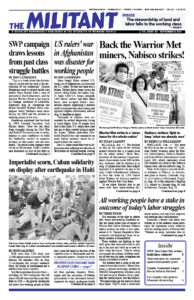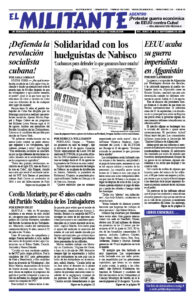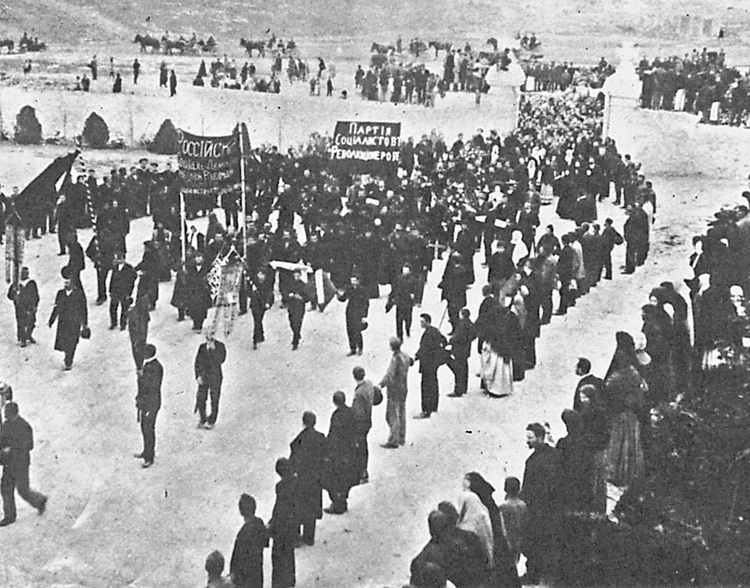One of Pathfinder’s Books of the Month for August is Workers of the World and Oppressed Peoples, Unite! Proceedings and Documents of the Second Congress of the Communist International, 1920 (Vol. 2). Delegates came to the congress from 37 countries in Europe, Asia, the Americas and Australia. This excerpt is from “Preliminary Draft Theses on the Agrarian Question,” by V.I. Lenin, the central leader of the 1917 Russian Revolution and of the Communist International. Key to the Bolsheviks leading working people to conquer power was their Marxist program to forge an alliance of workers and peasants. In his theses, Lenin draws on the lessons of that experience to help guide revolutionary parties inspired by the Russian Revolution worldwide. Copyright © 1991 by Pathfinder Press. Reprinted by permission.
BY V.I. LENIN
- Only the urban and industrial proletariat, led by the Communist Party, can liberate the working masses of the countryside from the yoke of capital and landed proprietorship, from ruin and the imperialist wars that will inevitably break out again and again if the capitalist system remains. There is no salvation for the working masses of the countryside except in alliance with the Communist proletariat, and unless they give the latter devoted support in its revolutionary struggle to throw off the yoke of the landowners (the large landed proprietors) and the bourgeoisie.
On the other hand, the industrial workers cannot accomplish their epoch-making mission of emancipating mankind from the yoke of capital and from wars if they connect themselves to their narrow craft or trade interests and smugly restrict themselves to attaining an improvement in their own conditions. …
The proletariat is a really revolutionary class and acts in a really socialist manner only when it comes out and acts as the vanguard of all the working and exploited people, as their leader in the struggle for the overthrow of the exploiters; this, however, cannot be achieved unless the class struggle is carried into the countryside, unless the rural working masses are united about the Communist Party of the urban proletariat, and unless they are trained by the proletariat.
- The working and exploited people of the countryside, whom the urban proletariat must lead into the struggle or, at all events, win over, are represented in all capitalist countries by the following classes:
First, the agricultural proletariat, wage laborers (by the year, season, or day) who obtain their livelihood by working for hire at capitalist agricultural enterprises. The organization of this class (political, military, trade union, cooperative, cultural, educational, and so on) independently and separately from other groups of the rural population, the conduct of intensive propaganda and agitation among this class, and the winning of its support for the soviets and the dictatorship of the proletariat constitute the fundamental tasks of the Communist parties in all countries.
Second, the semiproletarians or peasants who till tiny plots of land, that is, those who obtain their livelihood partly as wage laborers at agricultural and industrial capitalist enterprises and partly by working their own or rented plots of land, which provide their families only with part of their means of subsistence. This group of the rural working population is very numerous in all capitalist countries. …
If the work of the Communist Party is properly organized, this group will become its assured supporter, for the lot of these semiproletarians is a very hard one and they stand to gain enormously and immediately from soviet government and the dictatorship of the proletariat.
Third, the small peasantry, that is, the small-scale tillers who, either as owners or as tenants, hold small plots of land that enable them to satisfy the needs of their families and their farms and who do not hire outside labor. This stratum, as such, undoubtedly stands to gain by the victory of the proletariat, which will fully and immediately bring it (a) deliverance from the necessity of paying the large landowners rent or a share of the crop; … (b) deliverance from mortgages; (c) deliverance from the numerous forms of oppression by and dependence on the large landowners (forest lands and their use, etc.); (d) immediate aid for their farms from the proletarian state (the use of the agricultural implements and part of the buildings on the large capitalist farms confiscated by the proletariat and the immediate conversion, by the proletarian state, of the rural cooperative societies and agricultural associations from organizations that under capitalism served above all the rich and middle peasants into organizations that will primarily assist the poor, that is, proletarians, semiproletarians, small peasants, etc.), and many other things.
At the same time the Communist Party must clearly realize that during the transitional period from capitalism to communism, that is, during the dictatorship of the proletariat, this stratum, or at all events part of it, will inevitably vacillate toward unrestricted freedom of trade and the free enjoyment of the rights of private property. That is because this stratum, which, if only in a small way, is a seller of articles of consumption, has been corrupted by profiteering and by proprietary habits. However, if a firm proletarian policy is pursued, and if the victorious proletariat deals very resolutely with the large landowners and the large peasants, this stratum … will side with the proletarian revolution.
- Taken together, the three groups enumerated above constitute the majority of the rural population in all capitalist countries. That is why the success of the proletarian revolution is fully assured, not only in the cities but in the countryside as well. The reverse view is widespread. However, it persists only, first, because of the deception systematically practiced by bourgeois science and statistics, which do everything to gloss over both the gulf that separates the above-mentioned classes in the countryside from the exploiters — the landowners and capitalists — and that which separates the semiproletarians and small peasants from the large peasants.


